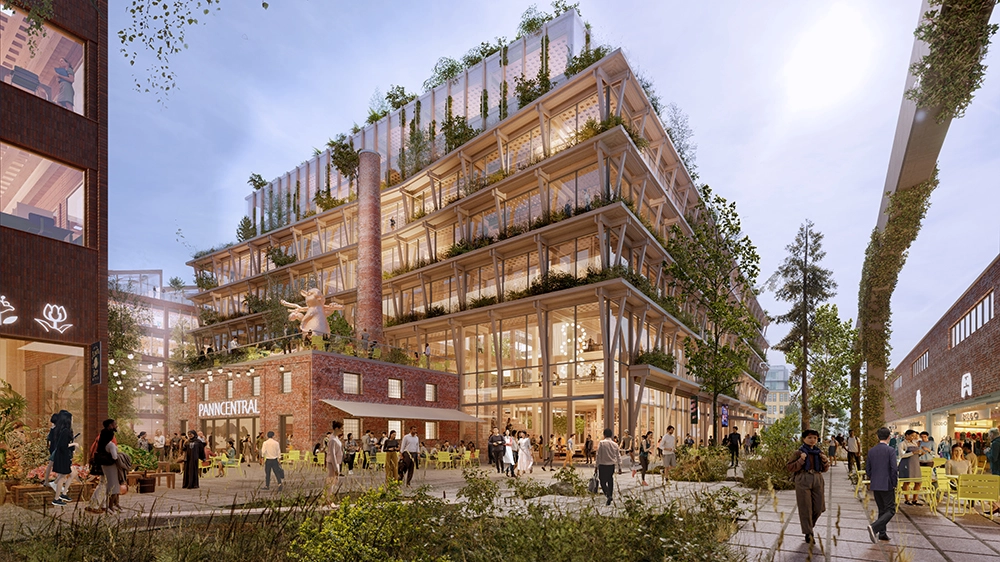Swedish developers are getting ready to build the world’s largest wooden city, setting the stage for a possible domino effect of similar projects across the globe.
Why it matters: The use of timber in urban construction has been found to produce significantly lower carbon emissions than conventional building materials — but it also brings new risks.
- The biggest is the fire safety risk associated with wooden buildings — though that’s a divisive point. Proponents say fears of inflated fire risks are misinformed, while skeptics point to issues concerning fire safety regulations.
Driving the news: The “world’s largest urban construction project in wood” will be built in Stockholm, Sweden, according to an announcement by real estate developer Atrium Ljungberg.
- It will feature 7,000 office spaces and 2,000 homes across over 250,000 square meters, a “mix of workplaces, housing, restaurants and shops” that The Economist reported will cost roughly $1.4 billion.
- Designed by architecture firms White Arkitekter and Henning Larsen, construction on “Stockholm Wood City” is slated to begin in 2025 and will take a decade to complete.
The big picture: From a college campus building made almost entirely out of timber in Singapore to the 280-foot-tall timber skyscraper dotting Norway’s skyline, architecturally innovative buildings made with wood composites have been picking up momentum.
Zoom in: With the building and construction industry responsible for almost 40% of global emissions, there’s a climate case for building with mass timber — which encompasses a number of engineered wood products used in construction — that is a major part of the appeal.
- Studies have found that swapping in mass timber for steel and concrete in mid-rise structures can reduce emissions associated with manufacturing, transporting, and installing building materials by up to 26.5%.
Yes, but: Some researchers have argued that because of a lack of data surrounding the total carbon impact picture of mass-timber buildings, the use of mass timber in building projects may result in a production process that is more emissions-intensive than previously understood.
- Plus, a lack of clarity and congruency concerning fire safety regulations can be another sticking point.
- Experts have warned that architect proponents “must improve their understanding of fire safety or risk disaster,” Dezeen magazine reported — citing the lack of a consensus across different building code jurisdictions about safety limitations as one problem.
What they’re saying: In the case of “Stockholm Wood City,” Annica Ånäs, CEO of Atrium Ljungberg, told Axios in an email that the project meets the “same high safety requirements as all other constructions” — including fire safety.
- She noted that the wood used is “specifically designed for its purpose,” citing how engineered wood forms a protective char layer on the surface that retains much of its structural strength, “contributing to a safer structure.”
Meanwhile: In the U.S., interest in modern timber building — notably in the form of wooden skyscrapers and a nine-acre timber airport roof — has been steadily growing.
- Last year, Fast Company reported there were some 1,300 mass-timber buildings being constructed or already developed across the country, a number expected to climb as cities continue to adapt their building codes.
What we’re watching: While the use of mass timber in lower-density residential construction is common nationwide, an entire city built out of timber isn’t likely anytime soon, said Urban Institute researcher Andrew Rumbach.
- “There was an era where we built cities out of wood, and cities burned down,” Rumbach told Axios, noting that many building codes would have to first be updated, as a good portion have their origins in urban fires.
- Another barrier to a “Stockholm Wood City” replica popping up in the U.S. is geography, according to Rumbach, who studies housing and community risk to hazards and climate change.
- “Where are you going to build an all-wood city? It’s probably going to need to be somewhere where there is relatively low risk from wildfire, because you wouldn’t necessarily want an all-wood city in a wildfire-prone region.”
The other side: Katie Mesia, a design resilience leader and principal at Gensler, a global architecture and design firm based in the U.S., told Axios she’s optimistic about the imminent likelihood of an American version of Sweden’s “wood city.”
- She noted that the development project is the latest example of a growing “tidal wave” of interest in modern building with mass timber — spreading more rapidly across Europe, but also increasing within the U.S.
The bottom line: “I am convinced that we will see more such projects across the world,” Atrium Ljungberg’s Ånäs told Axios.
- “I just think people need to see examples of it. Now when they do, I am sure they will be inspired.”
Source : AXIOS

